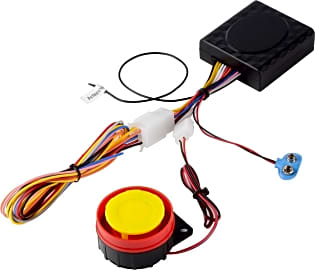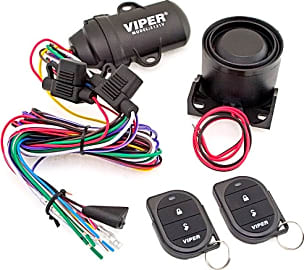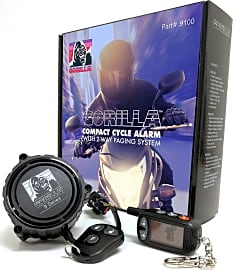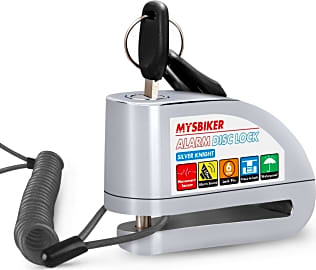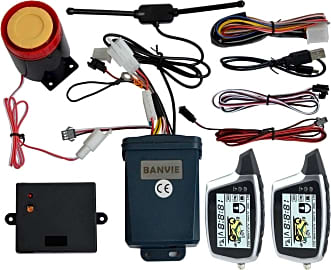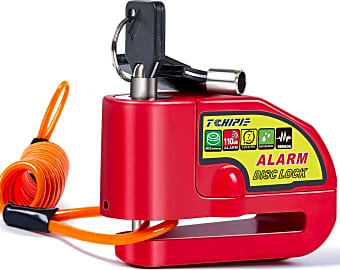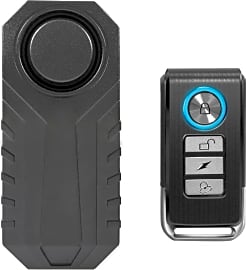The 10 Best Motorcycle Alarms

This wiki has been updated 43 times since it was first published in May of 2016. The good thing about using motorcycles or scooters as a primary form of transportation is that they are small, so they can zip in and out of traffic on busy city streets, and you can park them just about anywhere. The bad thing is that they are also prime targets for opportunistic thieves. Protect your ride simply and effectively with one of these alarms, many of which double as locks. When users buy our independently chosen editorial picks, we may earn commissions to help fund the Wiki.
Editor's Notes
September 16, 2020:
The one newcomer to our ranking is the Banvie Two-Way Anti-Hijacking, which has a lot of useful elements, including backlit screens on its pair of remotes that give you status updates about your bike. It also has a surprisingly good range. Ultimately, however, the system's durability kept it from cracking the top spots.
Personally, since I moved from the outskirts of LA closer to the city center, I've found one of these to be a necessity, and I opted for the Scorpio SRX-950 for the utter simplicity of its proximity arm/disarm function. I might have liked to save some coin and go with a simple disc brake lock like the Abus Granit Detecto X-Plus or the MysBiker Silver Knight, but I've got a high pair of tail pipes on a Scrambler, and custom panniers can get expensive, so I don't have any saddlebags to speak of. There are some excellent backpacks for motorcycling out there, but I don't always want to have one on me.
Keep an eye on installation complexity and battery care. If the setup keeps you from installing it, you're bike will be vulnerable until you do. And wired alarms can easily drain your battery if left on too long without running the bike, so if you have a dedicated parking spot that's safe near your home, and you only need the alarm to function when you're out and about, consider adding a trickle charger to your setup and reconnecting everything before you go out riding.
July 03, 2019:
Alarms are a great way to enhance the security of your motorcycle. They come in a variety of forms, each of which offers a different level of theft deterrence. An alarm that is incorporated into a disc lock, such as the MysBiker Silver Knight, Abus Granit Detecto X-Plus 8077, and Tchipie Disc Lock, combines physical deterrence with audible. While these are a great way to keep your motorcycle safe, some people may find having to attach a lock to the disc every time they park their bike to be a hassle. Storing it while riding could also be an issue for someone who doesn't have any saddlebags.
Another option is to go with an alarm that connects to the bike's electrical system. Some, like the Scorpio SRX-950, have the ability to remotely stop the engine to prevent hot wiring. Others, like the BlueFire Security Kit and Rupse CE21, can flash the indicators at the same time as sounding a siren to attract even more attention.
If you know that you will be out of ear shot of your alarm, but still want to be aware if someone is tampering with your bike, you may want to consider the Gorilla Automotive 9100. It comes with a pager system that works up to a half a mile away and vibrates to alert you if the alarm has been triggered. Of all the models on our list, the Scorpio SRX-950 is probably the most convenient option, as it arms itself automatically when you walk away, and disarms itself as you approach.
The Must-Have Motorcycle Alarm
It's generally accepted among criminology experts that most car steering wheel locking devices will not prevent a determined criminal from stealing a car.
A car's first line of defense against theft are the locks on its doors. A locked car makes it difficult for a potential thief to enter the cabin without the use of force. If a criminal presses his or her violation beyond the locks and forces entry, either by using a tool or simply by smashing a window, the next line of defense most vehicles have is their alarm system.
Motorcycles, on the other hand, have no doors to lock and no windows to roll up. Their only protection against a determined and experienced thief is, therefore, an excellent alarm. Without a motorcycle alarm, your bike is at risk of theft even when secured by a chain or other type of lock — unfortunately, even the most robust chains or locks will only slow the determined crook; they will not stop the theft. A great motorcycle alarm, however, can alert you and anyone in the area to an attempted theft as it occurs, and many alarms can even render a motorcycle temporarily inoperable, thwarting a thief's nefarious aims even if no one arrives to heed the alarm's call.
There are many varieties of motorcycle alarm that sound a siren; this is the most typical feature of these systems. Some devices also lock up the wheels of your bike, preventing even a determined thief from stealing the vehicle unless they can physically heft it into a truck or van (which is unlikely with most full-sized motorcycles). These types of alarms are good options for the rider who will be far away from his or her cycle and likely be unable to respond the the shriek of the alarm. Others use a silent alarm that alerts you to a theft in progress, allowing you to contact the authorities or respond yourself without alerting the criminal that their activity has been discovered. Whichever motorcycle alarm system you choose, don't go without any such device.
It's generally accepted among criminology experts that most car steering wheel locking devices will not prevent a determined criminal from stealing a car. However, that is not entirely the point of these units; rather, they are intended to make the attempted theft of a car seem more laborious and less attractive, leading a thief to pass on their attempt. A motorcycle can be secured in much the same way with the addition of other security features.
Disc brake locks, for example, attach to the spokes of a motorcycle's wheel and render the bike inoperable until removed. A crook wishing to steal your bike must first remove the lock, which may provide more time for people to respond to the vibration-triggered alarm the thief sets off. A thick bike security chain can also deter or slow a thief. Every second the person spends working to unlock or cut through the chain is time they are not spending getting away with your property. The pairing of these locking devices with a silent alarm may well be the best way to protect your bike and catch a criminal at the same time.
What Do Motorcycle Alarms Do, Anyway?
Almost all motorcycle alarms have one feature in common, and that is the ability to produce an ear-splitting siren sound, usually registered at around 120 dB in volume. This extremely loud sound is beneficial for two reasons: first, of course, it can be heard from afar, even inside a home or office, thereby alerting you and others that there is a problem that merits immediate response. Second, at around 120 dB, a siren's wail is so loud and unpleasant that a human without hearing protection will likely retreat at once, breaking off their theft attempt. (In fact, 120 dB sound bursts can even cause acute temporary hearing damage; a price any thief deserves to pay.)
Such units often have GPS tracking ability, so even if the crook gets away with the motorcycle, he or she can be easily followed and brought to justice.
It's a fine idea consider a system with a perimeter sensor, especially if you live in a suburban or rural area or you park your bike in a dedicated spot in a parking lot or garage. When engaged, these systems emit a warning tone when someone comes too near to your bike, sounding the full alarm on contact. A perimeter sensor is not a viable option for use in crowded areas, though, as pedestrians and other vehicles will set it off constantly.
Some motorcycle security devices do not emit audible sirens, but rather transmit data to a receiver or to your smartphone when the unit detects vibrations or when the bike is turned on. This silent alarm approach can help you catch a thief in the act. Such units often have GPS tracking ability, so even if the crook gets away with the motorcycle, he or she can be easily followed and brought to justice. These devices can help you recover your property and may potentially help jail a thief instead of merely scaring the criminal back into the shadows at the sound of an alarm.
Motorcycle Theft Statistics
There are a lot of motorcycles rolling around on America's streets and highways. According to a report by the Department of Transportation, there were approximately 8,410,000 motorcycles registered in the United States in 2011. Now, consider the number of motorcycles stolen in a given year, which between 2012 and 2015 averaged just under 45,000 thefts annually. That means your bike has about a one percent chance of being stolen in a given year if you take the numbers directly.
But further research reveals that motorcycle theft statistics vary greatly from place to place.
But further research reveals that motorcycle theft statistics vary greatly from place to place. As it turns out, New York City usually leads the nation in terms of stolen motorcycles, followed by Las Vegas and then San Diego. Residents of these cities should take extra precaution when parking their bikes in public. (For interest, the next most common city for theft on a per capita basis is Indianapolis, followed by Miami.)
As for states with the most common motorcycle theft incidents, these are, in order of descending magnitude: California, Florida, Texas, and North Carolina. This makes perfect sense when one considers the mild climates of said states, where conditions for motorcycle riding are generally more favorable.
Overall, the country saw a slight decrease in motorcycle theft in the last year for which we have full data; 2015 saw a 1-percent drop in these crimes. But that is cold comfort to the many annual victims of this crime, especially in light of another statistic: 61 percent of motorcycles that are stolen are never again recovered by their owners. Yet another good reason to prevent a theft in the first place.


